![]()
![]()
![]()
Use LEFT and RIGHT arrow keys to navigate between flashcards;
Use UP and DOWN arrow keys to flip the card;
H to show hint;
A reads text to speech;
116 Cards in this Set
- Front
- Back
|
Cycloalkanes |
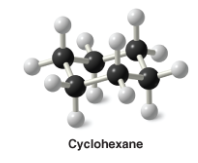
- All or some of the atoms are arranged in a ring - general formula CnH2n+2 |
|
|
Petroleum |
* Source of alkanes |
|
|
Cracking |
* Process of breaking down the molecules of larger alkanes into smaller ones |
|
|
Unbranched Alkanes |

* Straightest possible arrangement |
|
|
Branched Alkanes |

|
|
|
Alkane Stem Names 1-5 |
meth-, eth-, prop-, but-, and pent- |
|
|
Alkane Stem Names 6-10 |
hex-, hept-, oct-, non-, dec- |
|
|
Unbranched Alkyl Group Names |

|
|
|
Parent Name of Alkane |

- locate the longest continuous chain of C atoms - if 2 chains of equal length, choose chain with greater # of substituents - Ex Hexane |
|
|
Numbering Carbons of Parent Chain |

- beginning with the end of the chain nearer the substituent - if substituents are equidistant at both ends, choose name that gives lower number |
|
|
Substituent Group |

- Use carbon numbers of parent chain to designate location - Give each substituent a number, listed alphabetically - when substituents are identical, use prefix di-, tri-, tetra- |
|
|
Four Carbon Alkyl Groups |

- disregard structure defining prefixes written in italics and separated by a hyphen
|
|
|
Three Carbon Alkyl Groups |

- systematic name for isopropyl is 1-methylethyl - numbering always begins at point where group Is attached to main chain
|
|
|
Neopentyl Group |

- five carbon alkyl group |
|
|
Three Carbon Alkyl Group Nomenclature Examples |

|
|
|
Classification of H Atoms |

- classified based on the carbon they are attached to |
|
|
Naming Alkyl Halides (Haloalkanes) |

- if both a halo and alkyl are attached to parent chain, number from the end nearer to first substituent. - if equal distance number carbon near alphabetical precedence |
|
|
Functional Class Nomencature |

- system for naming compounds - uses two or more words - final word corresponds to functional group - preceding words describe remainder of molecule alphabetically |
|
|
Substitutive Nomenclature |

- each atom or group (substituent) is cited as a prefix or suffix to parent compound - Only one group can be cited as suffix - Locants (numbers) are used to tell where the group occurs |
|
|
Naming Alchohols |

- numbering of chain always begins at the end nearer the group named as suffix (OH) - drop -e and add suffix -ol - locant for suffix can either appear before parent name or before suffix (4-methylhexan-1-ol) - select longest parent chain to which OH is attached |
|
|
Common Functional Class Alcohols |

|
|
|
Glycol |

-AKA diol in substitutive system - alcohols containing 2 OH groups |
|
|
Cycloalkanes |

- Alkanes in which some or all of the carbon atoms are arranged in a ring - cyclo- added to beginning of alkane name - Saturated cycloalkanes have the general formula CnH2n |
|
|
Naming Cycloalkanes with 1 Substituent |

- with one ring and one substituent: add name of substituent to beginning of parent name
|
|
|
Naming Cycloalkanes with 2 or More Substituents |

- number carbons starting at the substituent first in alphabet, in the direction that give other substituents the lowest number - With 3 or more substituents: begin carbon numbering at substituent that leads to the lowest locants - Substituents are listed in name in alphabetical order |
|
|
Cycloalkylalkanes |

- When ring system is attached to a single chain with a greater number of C atoms, or when more than one ring is attached to a single chain |
|
|
Naming Bicyclic Cycloalkanes |

- contains 2 fused or bridged rings - use name corresponding to total number of carbon atoms in rings as parent name - add bicyclo- |
|
|
Bridge |

- Caron atoms connecting bridgeheads |
|
|
Bridgheads |

- C atoms common to both rings |
|
|
Brackets in Naming Bicycloalkanes |

- denotes number of C atoms in each bridge in order of decreasing length |
|
|
Naming Bicycloalkanes with Substituents |

- number ring system beginning at bridge head - proceed along longest bridge to other bridgehead - then along next longest bridge back to first bridgehead - then shortest bridge numbered last
|
|
|
Older Names for Alkenes |

|
|
|
Naming Alkenes |

- select longest chain with double bond as parent chain, change ending to -ene - number chain beginning at end closest to double bond - designate locant for double bond as a prefix of parent name or -ene suffix - indicate locations of substituents by numbers of carbon atoms they are attached |
|
|
Naming Substituted Cycloalkenes |

- number carbons so atoms on double bond have 1 and 2 - gives substituent the lower numbers - do not need to specify position of double bond |
|
|
Alkenols or Cycloalkenols |

- give alcohol number the lowest number |
|
|
Vinyl Group |

- alkenyl group - ethenyl -C2H3 |
|
|
Allyl Group |

- alkenyl group - prop-2-en-l-yl |
|
|
cis and trans Alkenes |

- if 2 identical or substantial groups are on same side of the double bond it is cis - if the groups are on opposite side, it is trans |
|
|
Naming Unbranched Alkynes |

- chain is numbered to give lowest numbers to triple bond carbons |
|
|
Naming Alkynol |

- OH group has priority over triple bond when numbering Carbons |
|
|
Terminal Alkynes |
- monosubstituted acetylenes - called ehynyl group as a substituent |
|
|
Acetylenic Hydrogen Atom |
- H atom attached to 1 Carbon in a terminal alkyne |
|
|
Alkynide Ion |

- anion obtained when acetylenic H is removed - Useful in synthesis |
|
|
Homologous Series |
- series of compounds in which each member differs from the next member by a constant unit - members of the series are called homologues |
|
|
Unbranched Alkane Homologue Series |
- at room temperature - C1 - C4 are gases - C5 - C17 are liquids - C18 and up are solids |
|
|
Boiling Points of Alkanes |

- increases with increasing molecular weight when umbranched (graph) - due to increase in molecular surface area which increases strength of dispersion forces - chain branching makes a molecule more compact, reducing surface area, and lowering boiling point |
|
|
Melting Points of Unbranched Alkanes |

- increases with increased molecular weight, but not as smooth as boiling point (blue) - however is smoother when even and odd carbon chains graphed separately - Even number carbon alkanes pack more closely in crystalline state, so they have a higher melting point - cycloalkanes have higher melting points than open chain counterparts |
|
|
Density of Alkanes |
- alkanes and cycloalkanes are the least dense of all organic compound groups - all densities less than 1 g/mL |
|
|
Solubility of Alkanes & Cycloalkanes |
- almost totally insoluble in water, due to very low polarity and inability to form H bonds - liquid alkanes and cycloalkanes are soluble in one another - dissolve in solvents of low polarity - Good solvents: benzene, carbon tetrachloride, chloroform, and other hydrocarbons |
|
|
Conformations |
- temporary shapes that result from rotation about a single sigma bond |
|
|
Conformer |
- each individual structure of a conformation |
|
|
Conformational Analysis |
- analysis of energy changes that a molecules undergoes as its groups undergo rotation about the single bonds that join them |
|
|
Newman Projection Formula |

- means of representing the spatial relationships of groups attached to two atoms of a molecule - take view from one atom (usually a C) directly along a selected bond axis tot eh next atom (usually a C)
|
|
|
Sawhorse Formula |

- chemical formula that depicts the spatial relationships of groups in a molecule - similar to dash wedge formula |
|
|
Staggered Conformation |

- conformation where the dihedral amgle between bonds at each of the C-C bonds is 180 degrees - atoms or groups bonded to each end of a C-C bond are as far apart as possible - most stable (allows for max separation of electron pairs) - also stabilized by hyperconjugation to a lesser degree |
|
|
Dihedral Angle |
- angle between atoms or groups bonded to adjacent atoms - when viewed as a projection down the bond between adjacent atoms |
|
|
Eclipsed Conformation |

- atoms bonded to carbons at each end of a C-C bond are directly opposed to one another - dihedral bond angle is 0 |
|
|
Hyperconjugation |
- favorable overlap between filled and unfilled sigma orbitals in the staggered conformation - helps to stabilize staggered conformations |
|
|
Potential Energy Diagram |

|
|
|
Torsional Barrier |
- barrier to rotation of groups joined by a single bond - caused by repulsions between aligned electron pairs in the eclipsed form - some molecules will wag back and forth with atoms in staggered or nearly staggered conformations - molecules with more energy will rotate through an eclipsed conformation to another staggered conformation
|
|
|
Torsional Barrier - Ethane |
- unless T is very low, ethane molecules will usually have enough energy to undergo bond rotation from one conformation to another |
|
|
Conformational Analysis of Butane |

- barriers are larger than ethane, but still not large enough to isolate gouche and anti-conformations - need extreme low temps to do that |
|
|
Torsional Strain |
- strain associated with an eclipsed conformation of a molecule - caused by repulsions between the aligned electron pairs of the eclipsed bonds (Steric Hindrance) - result of repulsive dispersion forces that cannot be relieved due to restriction of conformational mobility |
|
|
Steric Hinderance |
- repulsive interactions between electron clouds of bonded groups |
|
|
Torsional Strain - Butane |

- results from steric hindrance between terminal methyl groups and H atoms at C-2 and C-3 - also from steric hindrance directly between the 2 methyl groups |
|
|
Anti-Conformation (I) |

- does not have torsional strain - groups are staggered - methyl groups are 180 degrees |
|
|
Gauche Conformations |

- examples of stereoisomers - methyl groups are close enough that dispersion forces between them are repulsive - 60 degrees between methyl groups - more energy than anti-conformation |
|
|
Eclipsed Conformations |

- energy maxima in potential diagram - II and VI have repulsive dispersion forces arising from the eclipsed methyl groups and H atoms - IV has greatest energy due to added large dispersion forces between eclipsed methyl groups |
|
|
Dispersion Forces |
- can be attractive or repulsive which depends on the distance that separates the 2 groups - as 2 nonpolar groups are brought closer together, attraction increases to a maximum (van der waals radii) - van der waals radii is a measure of the group's size - as distance decreases past maximum, repulsion occurs |
|
|
Stereoisomers |
- same molecular formula and connectivity - but different arrangements of atoms in 3D space |
|
|
Conformational Stereoisomers |
- differing in space only due to rotation about single bonds |
|
|
Stability of Cycloalkanes |
- cyclohexane is most stable cycloalkane - difference in stability is due to ring strain |
|
|
Ring Strain |
- comprises angle strain and torsional strain |
|
|
Angle Strain |
- increase potential energy of a molecule (usually Cyclic) - result of deviation from ideal bond angles - caused by inherent structural constraints |
|
|
Ring Strain - Cyclopropane |

- sp3 hybridized, however bond angles are 60 degrees. Not ideal - angle strain due to C-C sigma bonds cannot overlap as effectively as alkanes - orbitals contain more p character - C-C bonds are weaker, and as a result the molecule has more potential energy - C-C bonds are considered bent |
|
|
Ring Strain - Cyclobutane |

- sp3 hybridized but has internal angles of 88 degrees - ring is not planar but slightly folded, too much torsional strain if planer |
|
|
Ring Strain - Cyclopentane |
- sp3 hybridized, but internal angles are 108 degrees - conformation is slightly bent, in which 1 or 2 of the atoms are out of plane - if planer: very little angle strain but high torsional strain due to eclipsed conformation - slight twisting of C-C atoms can occur with little change in E - causes atoms to move into plane and causes others to move out - makes the molecule flexible shifting rapidly from one conformation to another - almost as stable as hexane |
|
|
Cyclohexane Conformations |

- chair conformation - boat conformation - twist conformation - 99% of molecules are estimated to be in chair conformation |
|
|
Chair Conformation |
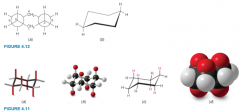
- cyclohexane - all C-C bonds are 109.5 - free of angle and torsional strain - bonds are staggered - H atoms at opposite corners of the ring are maximally separated - most stable, but more rigid than boat conformation |
|
|
Boat Conformation |

- cyclohexane - no angle strain - C-H bonds are eclipsed, causing torsional strain - H atoms of C1 and C4 are close enough to cause van der waals repulsions (flagpole attractions) - flexible |
|
|
Twist Conformation |

- flexes from boat conformation - relieves torsional strain - reduces flagpole interactions - more stable than boat conformation but not chair conformation |
|
|
Conformations of Higher Cycloalkanes |
- also exist in nonplanar conformations, essentially free of angle strain - instabilities caused by torsional strain and transannular strain
|
|
|
Transannular Strain |
- Repulsive dispersion forces between H atoms across rings |
|
|
Catenanes |

- large rings threaded on chains - large rings that are interlocked like links in a chain |
|
|
Olympiadane |
- catenane containing a linear array of 5 interlocking rings |
|
|
Axial Bonds |

- H bonds perpendicular to the average plane of the ring - when cyclohexane is in chair conformation - H atoms in red
|
|
|
Equatorial Bonds |

- H bonds that extend from perimeter of ring - when cyclohexane is in chair conformation - H atoms in black - alternate from slightly up to slightly down in their orientation from one carbon to the next |
|
|
Chair-Chair Ring Flip |

- change in cyclohexane ring converting one chair conformation to another - axial bonds become equatorial and vice versa |
|
|
Drawing Chair Conformational Structures |

- set of parallel lines define opposite sides of chair - equatorial bonds are parallel to ring bonds that are one away in either direction - if vertex of ring points up: axial points up and equatorial bond is angled slightly down - if vertex points down: axial bond points down and equatorial bond is angles slightly upward |
|
|
Chair Conformations of Methylcyclohexane |

- interconvertable via ring flip - in conformation I, methyl group occupies the axial position - In conformation II, methyl groups occupies the equatorial position (most stable) |
|
|
Stability of Conformation for a Monosubstituted Cyclohexane Ring |

- most stable conformation is where substituent is equatorial - when axial, 1,3-diaxial interactions occurs between group and axial H atoms - generally less repulsion when any group larger than H is equatorial rather than axial |
|
|
1,3-Diaxial Interactions |

- interaction between 2 axial groups that are on adjacent C atoms |
|
|
1,3-Diaxial Interactions of tert-Butylcyclohexane |

- strain more pronounced because butyl is a larger alkyl substitute - equatorial conformation is much more stable than axial conformation - equatorial molecule is heavily favored at room temperature |
|
|
Stereoisomers |
- compounds with same molecular formula - differ only in arrangement of atoms in space - have the same connectivity, therefore are not constitutional isomers - classified as enantiomers or diastereomers |
|
|
Cis-Tran Isomers |

- Diastereomers - differ in stereochemistry at adjascent atoms of a double bond or on different atoms of a ring - Cis groups are on same side of double bond or ring - Trans are on opposite sides |
|
|
Trans 1,4-Distributed Cyclohexanes |

- two possible chair conformations - diequatorial is the more stable conformation |
|
|
Cis 1,4-Disubstituted Cyclohexane |
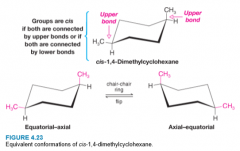
- both groups are attached by an upper bond or lower bond - exists in 2 equivalent conformations: axial-equatorial and equatorial-axial - not equivalent if one group is larger than the other |
|
|
Non-Equivalent Cis 1,4-Disubstituted Cyclohexane |

- one group is larger than the other - conformation with larger group equatorial will be more stable |
|
|
Trans 1,3-Disubstituted Cyclohexanes |
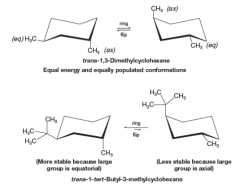
- one methyl group in axial position and 1 methyl group in equatorial position - equivalent if 2 groups are the same - non-equivalent if one group is larger, conformation where largest group is equatorial is most stable |
|
|
Cis 1,3-Disubstituted Cyclohexanes |
- 2 conformations - one in which both methyl groups are equatorial, which is more stable - one in which both methyl groups are axial
|
|
|
Trans 1,2-Disubstituted Cyclohexanes |

- conformation in which both methyl groups are equatorial, which is more stable - conformation in which both methyl groups are axial
|
|
|
Cis 1,2-Distributed Cyclohexanes |

- 2 equivalent chair formations, equal stability - one methyl group is axial - one methyl group is equatorial |
|
|
Decalin |
![- bicycle[4.4.0]decane](https://images.cram.com/images/upload-flashcards/33/30/62/9333062_m.png)
- bicycle[4.4.0]decane
|
|
|
Cis-Trans Isomerization - Decalin |
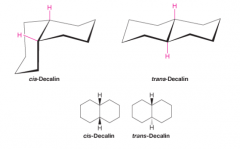
- cis-decalin 2 H atoms attached to bridgehead lie on the same side of ring - trans-decalin H atoms are on opposite sides - simple rotations of groups about C atoms do not interconvert - stereoisomers with different physical properties |
|
|
Adamantane |

- tricyclic system - contains 3D array of cyclohexane rings - all rings are in chair form |
|
|
Chemical Reactions of Alkanes |
- C-C and H-C bonds are strong and only break at high temperatures - C and H have nearly same electronegativity and are only slightly polarized, so they are generally unaffected by most bases - Have no unshared electrons to offer as sites for attack by acids - originally called paraffins (latin for little affinity) - However react vigorously with Oxygen when appropriate mixture is ignited - also react with Cl and Br - react explosively with F |
|
|
Hydrogenation |

- reaction in which hydrogen adds to a double or triple bond - accomplished through the use of a metal catalyst (platinum, palladium, rhodium, or ruthenium) |
|
|
Hydrogenation of Alkenes and Alkynes |

- Alkenes and Alkynes react with H in the presence of metal catalysts to produce alkanes - atoms of H molecule add to each atom of the C-C double or triple bond - alkene or alkyne is dissolved in solvent such as ethanol, add catalyst, and expose mixture to H gas under pressure |
|
|
Index of Hydrogen Deficiency |

- difference in the number of pairs of H atoms between compound under study and an acyclic alkane with the same number of carbons - each ring or double bond provides one unit of hydrogen deficiency |
|
|
Alkadienes |
- alkenes with 2 double bonds - General Formula CnH2n−2. |
|
|
Alkenynes |
- hydrocarbons with one double bond and one triple bond
|
|
|
Alkatrienes |
- Alkenes with 3 double bonds - CnH2n−4 |
|
|
Determaining IHD |

- Each double bond consumes one molar equivalent of hydrogen and counts for one unit of hydrogen deficiency - Each triple bond consumes two molar equivalents of hydrogen and counts for two units of hydrogen deficiency. - Rings are not affected by hydrogenation, but each ring still counts for one unit of hydrogen deficiency |
|
|
IHD for Compounds Containing Halogen Atoms |
- count halogen atoms as though they were H atoms |
|
|
IHD for Compounds Containing Oxygen Atoms |

- ignore O atoms and calculate IHD from the remainder of the formula - multiple structural possibilities (Ex. C4H6Cl2 |
|
|
IHD for Compounds Containing Nitrogen Atoms |

- subtract one hydrogen for each N atom - then ignore N atoms Ex. C4H9N |

